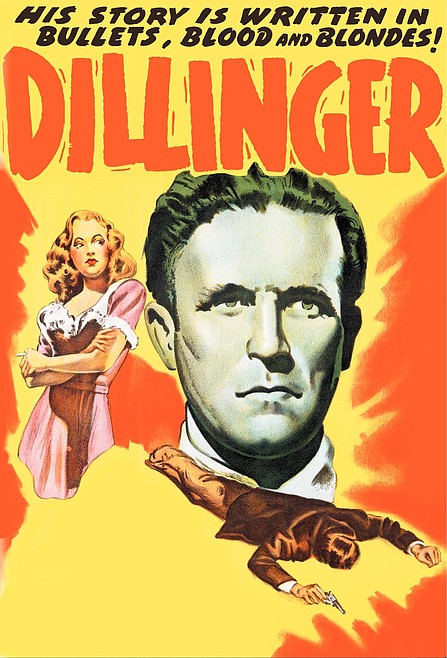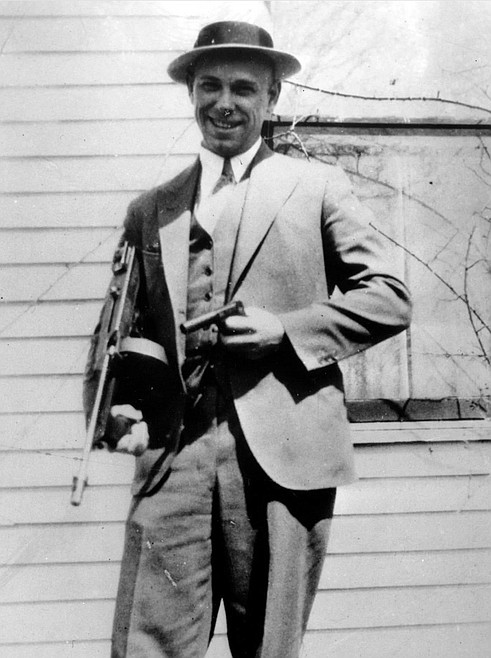Story of John Dillinger, J. Edgar Hoover and the Lady in Red
John Herbert Dillinger was one of America’s most famous criminals in the 1930s, a group that included Al Capone, Baby Face Nelson, Pretty Boy Floyd, Bugsy Siegel and Lucky Luciano. He was only 31 when the FBI got him in a shootout coming out of a movie theater and betrayed by his landlady.
Standing just 5-foot-7 and sporting a Clark Gable moustache, Dillinger and his gangster gang terrorized the Midwest, robbing banks, police stations and shooting cops or anyone else who got in their way.
He was no Robin Hood — he was a cold-blooded mobster who amazingly escaped murder charges even though he killed East Chicago policeman William Patrick O’Malley during a bank heist in the neighborhood.
The newspapers couldn’t get enough of him.
Dillinger relished the notoriety and the Robin Hood image that his persona generated.
His generosity was not to the poor and downtrodden — it was to his pals and prostitutes.
The closest he came to being a “Robin Hood” might have been when a farmer with a handful of money he was depositing was waiting for the next teller at the bank that the Dillinger gang was robbing.
Dillinger asked him if the money was his or the bank’s? The farmer said it was his.
“Keep it,” Dillinger said, “We only want the bank’s.”
John Dillinger was born on June 22, 1903, in Indianapolis — youngest of two children born to John Wilson Dillinger and Mary Ellen “Molly” Lancaster. His somber church-going father owned a grocery store and rental houses, and was described as “a harsh disciplinarian who would beat Johnnie for his insubordination, and then turn around and give him money for candy” while often locking his son up in the house when he was a teenager, and then let him roam the streets at night.
Johnnie’s mother died when he was only 4 and he was raised by his older sister until his father remarried. Then at age 16, John dropped out of school because he was bored and wanted to earn money on his own.
The money he “earned” was from petty theft that eventually led to him being placed in a reform school.
After being released, his rebellious behavior included drinking, fighting and visiting prostitutes.
In 1923, he joined the Navy and served on the USS Utah but soon deserted.
The following year, he married 16-year-old Beryl Ethel Hovious and tried to settle down. But within a few weeks he was arrested for stealing chickens.
Then he was caught holding up a Mooresville, Ind., grocer and spent the next 10 years in the Indiana State Prison. After years of waiting for him, his wife filed for divorce.
It was in prison where John Dillinger learned the art of holding up banks — taught by seasoned pros.
After being paroled in 1933, he put a small gang together and started using his new bank robbing skills, hitting five banks in Indiana and Ohio within four months.
Joining him was Harry “Pete” Pierpont as friend and mentor. A bright, born leader, Pierpont disliked publicity and allowed Dillinger to bask in all the notoriety. He was fiercely loyal and had a reputation for not squealing on his pals and taking care of the people around him.
He was executed in the Ohio Penitentiary electric chair three months after Dillinger was killed.
Dillinger’s escapades took place mainly during the Great Depression when banks and the rich were considered oppressors of the common people who were just trying to survive tough economic times.
It didn’t seem to bother them that those hardened criminals were running rampant in the American heartland. Soon he became a sort of folk hero.
When he was shot and killed in a Chicago alley, “Bystanders dipped handkerchiefs and pieces of their clothing in his blood as mementos,” one report said. “By the next morning, pieces of newsprint stained with Dillinger’s blood were selling for 25 cents per square inch.”
With ghoulish delight, 15,000 filed by his body in a Chicago morgue, and across the country newspapers ran wild with stories about Dillinger’s criminal life, “feeding the hysteria — and urban legends grew like Indiana tomatoes.”
But there was nothing heroic about him.
In September 1933, Dillinger was caught and jailed in Ohio, but a month later five former convict pals busted him out of Indiana State Prison, killing a deputy during the escape.
The gang then robbed banks in Indiana and Wisconsin before taking off to Florida and Arizona.
That was the beginning of the end for John Dillinger.
The gang was caught by Tucson police, with Dillinger extradited to Indiana, then sent to the supposedly escape-proof Crown Point Jail in northeastern New York.
In March 1934, Dillinger whittled a fake pistol out of a piece of wood with a razor and painted it black with shoe polish. Brandishing the fake gun, he forced his way past a dozen guards while singing “I’m heading for the last roundup.”
How prophetic that was! He had 141 days to live.
He stole the sheriff’s car and drove to Chicago, and by crossing state lines in a stolen vehicle, the theft became a federal crime.
FBI Chief J. Edgar Hoover assigned Chicago FBI Chief Melvin H. Purvis to lead the manhunt.
Joining Dillinger’s gang for two bank heists was another notorious mobster named Baby Face Nelson — also wanted by the FBI. His rap sheet included “accidental shooting; theft; bank robbery; murder; kidnapping; assault with intent to kill.”
He hooked up with Dillinger after being fired by mobster Al Capone for being too violent. The association didn’t last very long however. Dillinger was gunned down by FBI agents in July 1934, and Baby Face — remembered for being listed Public Enemy Number 1, his vicious killings and youthful appearance — was killed in a wild shootout with FBI agents in November.
In the summer of 1934, the FBI got lucky:
Ana Sage, whose real name was Ana Cumpanas, was the landlord of an apartment building in North Side Chicago occupied by Dillinger and his girlfriend Polly Hamilton. She was an Austro-Hungarian-born Romanian prostitute and brothel owner facing deportation after the authorities deemed her to be an “alien of low moral character.”
To save herself from deportation, she decided to tip off the FBI about Dillinger and claim the $10,000 reward money, telling Chicago FBI Chief Purvis that she’d help catch Dillinger. In return, she expected the reward money and his help in stopping the deportation proceedings.
Purvis agreed to the deal.
Ana then told him that Dillinger would be taking her and Polly to see a movie at either the Biograph or Marbro Theater, and that she’d be wearing a red dress to help identify Dillinger. She actually wore an orange dress. One report said the red dress looked orange under the theater’s night lights.
Nevertheless, Ana Sage would be forever remembered as the Lady in Red.
Purvis had both theaters staked out, and he waited at the Biograph.
The movie was “Manhattan Melodrama,” a crime film starring Clark Gable.
As Dillinger, Ana and Polly left the theater after the movie ended, Dillinger sensed danger and ran toward a nearby alley where FBI agents were waiting for him.
Within seconds, it was all over and the notorious John Dillinger lay dead in a pool of blood.
Ana Sage received only half the reward money; and the FBI reneged on helping her stop deportation proceedings, citing “bureaucracy or poor communication between branches of the federal government.”
She lost court appeals and was deported to Romania, where she died of liver disease in 1947.
John Dillinger is still in the news. There’s a question about the man that the FBI agents shot — was it really Dillinger?
Some researchers claim that another man — not Dillinger — was killed outside the Biograph and that the mobster’s allies pulled off a hoax on the FBI, leaving him free to disappear. However, fingerprints from the body matched those of Dillinger already on file from previous arrests.
To clarify the controversy once and for all, his nephew Michael C. Thompson has requested the body be exhumed from Crown Hill Cemetery for forensic analysis and possible DNA testing and then re-interred there.
So stay tuned.
The final chapter on the notorious John Dillinger may be written soon.
- • •
Contact Syd Albright at silverflix@roardrunner.com.
- • •
Tommy gun weapon of choice…
Mobsters during the Prohibition Era loved using the Tommy gun, a submachine gun invented by American John T. Thompson in 1918. It was also used by law enforcement officers. The Tommy gun was also known as Annihilator, Chicago Typewriter, Trench Broom, Chicago Submachine, Chicago Piano, Chicago Style, Chicago Organ Grinder, Drum Gun and the Chopper.
Dillinger epitaph…
On the night of Dillinger’s death, an unknown person wrote an epitaph in chalk on the pavement near the Biograph Theater:
Stranger, stop and wish me well,
Just a prayer for my soul in Hell.
I was a good fellow, most people said,
Betrayed by a woman all dressed in red.
FBI cover-up?…
In his book “Dillinger: Dead or Alive?,” researcher Jay Robert Nash theorized that the FBI was unable to catch the real John Dillinger, so they staged his killing, using an innocent victim as a cover-up, but not everyone agrees with the theory.
Grateful victims…
One report says, “Gang members were often described as shadowy figures, wearing dark overcoats with hat brims pulled down to hide their identities. The thieves would make swift movements and bark out sharp, crisp orders to ‘Get down and nobody gets hurt!’ Victims were described as helpless and grateful to have their lives spared.”
Old habits die hard…
John Dillinger joined the Navy to avoid jail for stealing a car, serving aboard the USS Utah before deserting a few months later. He was caught and dishonorably discharged, then returned to crime robbing a grocer of $50 when a friend told him the grocer would be easy pickings. Expecting a light sentence, he pleaded guilty but the judge sentenced him to 10 to 20 years.
- • •
‘Look for History Popcorn every Wednesday brought to you by Ziggy’s.’
Invitation to readers …
Everyone has a story. Press readers are invited to submit their Community History Popcorn stories (“Tasty little morsels of personal history”) for possible publication. Keep them 600 words or less. The stories may be edited if required. Submission of stories automatically grants permission to publish. Send to Syd Albright at silverflix@roadrunner.com.

























